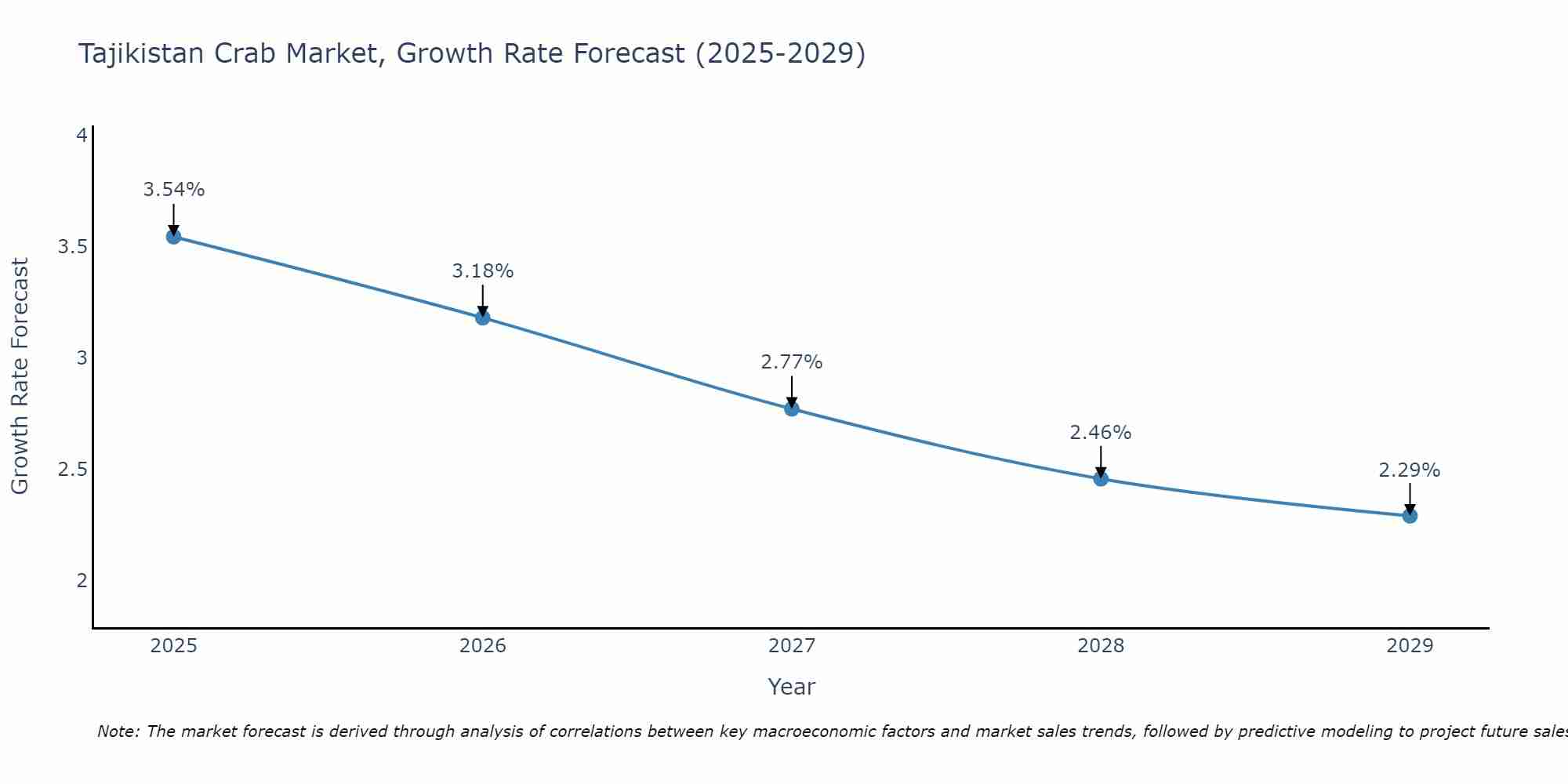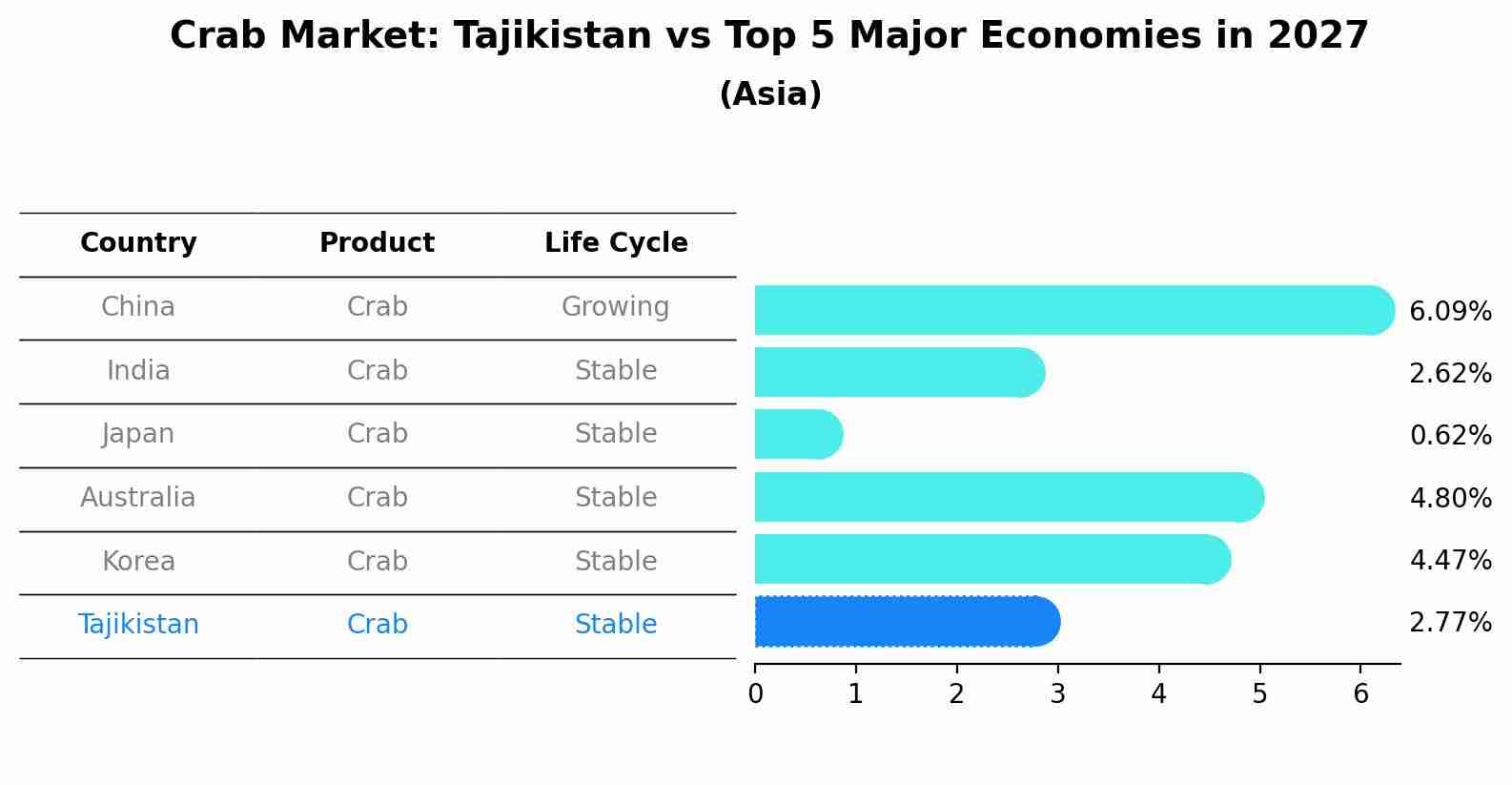Tajikistan Crab Market (2025-2031) Outlook | Trends, Growth, Companies, Size, Share, Revenue, Value, Analysis, Forecast & Industry
| Product Code: ETC088878 | Publication Date: Jun 2021 | Updated Date: Jun 2025 | Product Type: Report | |
| Publisher: 6Wresearch | Author: Dhaval Chaurasia | No. of Pages: 70 | No. of Figures: 35 | No. of Tables: 5 |
Tajikistan Crab Market Size Growth Rate
The Tajikistan Crab Market may undergo a gradual slowdown in growth rates between 2025 and 2029. Beginning strongly at 3.54% in 2025, growth softens to 2.29% in 2029.

Crab Market: Tajikistan vs Top 5 Major Economies in 2027 (Asia)
The Crab market in Tajikistan is projected to grow at a stable growth rate of 2.77% by 2027, within the Asia region led by China, along with other countries like India, Japan, Australia and South Korea, collectively shaping a dynamic and evolving market environment driven by innovation and increasing adoption of emerging technologies.

Tajikistan Crab Market Overview
The Tajikistan Crab Market is a niche industry within the country`s broader seafood sector. Despite being a landlocked country, Tajikistan imports a significant amount of crabs primarily from countries like Russia, China, and Iran to meet the demand of local consumers and restaurants. The market is characterized by relatively high prices due to transportation costs and limited availability, making crabs a luxury seafood item in Tajikistan. The most commonly consumed crab species in the country are king crabs and snow crabs, prized for their delicate flavor and meaty texture. The Tajikistan Crab Market is influenced by global seafood trends and local consumer preferences, with potential for growth as awareness and demand for premium seafood products continue to rise in the region.
Tajikistan Crab Market Trends
As of the latest data available, the Tajikistan Crab Market is experiencing a growing demand for crab products, driven by increasing consumer interest in seafood delicacies. The market is witnessing a shift towards sustainable sourcing practices and higher quality products, leading to a preference for wild-caught crabs over farmed ones. Additionally, there is a rising trend of incorporating crab meat into various cuisines and dishes, thereby expanding the market potential beyond traditional seafood consumers. However, challenges such as limited supply chains and infrastructure constraints continue to impact the market growth. Overall, the Tajikistan Crab Market is showing promising signs of development and opportunities for players to innovate and cater to the evolving preferences of consumers.
Tajikistan Crab Market Challenges
In the Tajikistan Crab Market, several challenges are faced that impact the industry. One major challenge is the limited supply of crabs due to overfishing and unsustainable harvesting practices. This leads to fluctuating prices and difficulties in meeting the demand for crabs in the market. Additionally, the lack of proper infrastructure and cold chain facilities for storage and transportation further hinders the market`s growth potential. Import restrictions and trade barriers also pose challenges for businesses looking to import crabs from other countries. Furthermore, the lack of awareness and promotion of Tajikistan crabs internationally limits their market reach and potential for export growth. Overall, addressing these challenges through sustainable fishing practices, investment in infrastructure, and market promotion efforts are crucial for the development of the Tajikistan Crab Market.
Tajikistan Crab Market Investment Opportunities
The Tajikistan Crab Market presents potential investment opportunities in the seafood industry due to its growing demand for high-quality crab products domestically and potentially in neighboring countries. Investing in crab farming or processing facilities could capitalize on this demand and provide a sustainable source of income. Additionally, there may be opportunities for export to international markets, leveraging Tajikistan`s strategic location between Central Asia and China. As the market continues to develop and consumer preferences for seafood products increase, investing in the Tajikistan Crab Market could offer long-term growth potential for investors looking to diversify their portfolio within the food industry. However, thorough market research and due diligence are essential to assess the feasibility and profitability of such investments in this emerging market.
Tajikistan Crab Market Government Policy
The Tajikistan government does not have specific policies related to the crab market as crab fishing is not a significant industry in the landlocked country. However, Tajikistan does have regulations in place to control and monitor the import and export of seafood products, including crabs, to ensure food safety and quality standards are met. The country may also have general regulations related to the protection of aquatic resources and biodiversity in its lakes and rivers. Overall, the Tajikistan government`s focus on the seafood market is likely limited, and policies related to crabs specifically would be minimal compared to larger seafood-producing countries.
Tajikistan Crab Market Future Outlook
The future outlook for the Tajikistan Crab Market appears to be promising with potential growth opportunities. As the demand for seafood continues to rise globally, Tajikistan`s crab market can capitalize on this trend by expanding its production and export capabilities. Additionally, advancements in aquaculture technology and sustainable fishing practices can help ensure a steady supply of high-quality crabs to meet the increasing consumer demand. The government`s focus on promoting the seafood industry and improving trade relations with key markets can further support the growth of the Tajikistan Crab Market. Overall, with the right strategies in place, Tajikistan has the potential to establish itself as a significant player in the international crab market in the coming years.
Key Highlights of the Report:
- Tajikistan Crab Market Outlook
- Market Size of Tajikistan Crab Market, 2021
- Forecast of Tajikistan Crab Market, 2031
- Historical Data and Forecast of Tajikistan Crab Revenues & Volume for the Period 2021 - 2031
- Tajikistan Crab Market Trend Evolution
- Tajikistan Crab Market Drivers and Challenges
- Tajikistan Crab Price Trends
- Tajikistan Crab Porter's Five Forces
- Tajikistan Crab Industry Life Cycle
- Historical Data and Forecast of Tajikistan Crab Market Revenues & Volume By Type for the Period 2021 - 2031
- Historical Data and Forecast of Tajikistan Crab Market Revenues & Volume By Blue Crab for the Period 2021 - 2031
- Historical Data and Forecast of Tajikistan Crab Market Revenues & Volume By Chinese Mitten Crab for the Period 2021 - 2031
- Historical Data and Forecast of Tajikistan Crab Market Revenues & Volume By Gazami Crab for the Period 2021 - 2031
- Historical Data and Forecast of Tajikistan Crab Market Revenues & Volume By Others for the Period 2021 - 2031
- Historical Data and Forecast of Tajikistan Crab Market Revenues & Volume By Form for the Period 2021 - 2031
- Historical Data and Forecast of Tajikistan Crab Market Revenues & Volume By Frozen for the Period 2021 - 2031
- Historical Data and Forecast of Tajikistan Crab Market Revenues & Volume By Canned for the Period 2021 - 2031
- Historical Data and Forecast of Tajikistan Crab Market Revenues & Volume By Others for the Period 2021 - 2031
- Tajikistan Crab Import Export Trade Statistics
- Market Opportunity Assessment By Type
- Market Opportunity Assessment By Form
- Tajikistan Crab Top Companies Market Share
- Tajikistan Crab Competitive Benchmarking By Technical and Operational Parameters
- Tajikistan Crab Company Profiles
- Tajikistan Crab Key Strategic Recommendations
Frequently Asked Questions About the Market Study (FAQs):
1 Executive Summary |
2 Introduction |
2.1 Key Highlights of the Report |
2.2 Report Description |
2.3 Market Scope & Segmentation |
2.4 Research Methodology |
2.5 Assumptions |
3 Tajikistan Crab Market Overview |
3.1 Tajikistan Country Macro Economic Indicators |
3.2 Tajikistan Crab Market Revenues & Volume, 2021 & 2031F |
3.3 Tajikistan Crab Market - Industry Life Cycle |
3.4 Tajikistan Crab Market - Porter's Five Forces |
3.5 Tajikistan Crab Market Revenues & Volume Share, By Type, 2021 & 2031F |
3.6 Tajikistan Crab Market Revenues & Volume Share, By Form, 2021 & 2031F |
4 Tajikistan Crab Market Dynamics |
4.1 Impact Analysis |
4.2 Market Drivers |
4.3 Market Restraints |
5 Tajikistan Crab Market Trends |
6 Tajikistan Crab Market, By Types |
6.1 Tajikistan Crab Market, By Type |
6.1.1 Overview and Analysis |
6.1.2 Tajikistan Crab Market Revenues & Volume, By Type, 2018 - 2027F |
6.1.3 Tajikistan Crab Market Revenues & Volume, By Blue Crab, 2018 - 2027F |
6.1.4 Tajikistan Crab Market Revenues & Volume, By Chinese Mitten Crab, 2018 - 2027F |
6.1.5 Tajikistan Crab Market Revenues & Volume, By Gazami Crab, 2018 - 2027F |
6.1.6 Tajikistan Crab Market Revenues & Volume, By Others, 2018 - 2027F |
6.2 Tajikistan Crab Market, By Form |
6.2.1 Overview and Analysis |
6.2.2 Tajikistan Crab Market Revenues & Volume, By Frozen, 2018 - 2027F |
6.2.3 Tajikistan Crab Market Revenues & Volume, By Canned, 2018 - 2027F |
6.2.4 Tajikistan Crab Market Revenues & Volume, By Others, 2018 - 2027F |
7 Tajikistan Crab Market Import-Export Trade Statistics |
7.1 Tajikistan Crab Market Export to Major Countries |
7.2 Tajikistan Crab Market Imports from Major Countries |
8 Tajikistan Crab Market Key Performance Indicators |
9 Tajikistan Crab Market - Opportunity Assessment |
9.1 Tajikistan Crab Market Opportunity Assessment, By Type, 2021 & 2031F |
9.2 Tajikistan Crab Market Opportunity Assessment, By Form, 2021 & 2031F |
10 Tajikistan Crab Market - Competitive Landscape |
10.1 Tajikistan Crab Market Revenue Share, By Companies, 2021 |
10.2 Tajikistan Crab Market Competitive Benchmarking, By Operating and Technical Parameters |
11 Company Profiles |
12 Recommendations |
13 Disclaimer |
- Single User License$ 1,995
- Department License$ 2,400
- Site License$ 3,120
- Global License$ 3,795
Search
Thought Leadership and Analyst Meet
Our Clients
Related Reports
- Afghanistan Apparel Market (2026-2032) | Growth, Outlook, Industry, Segmentation, Forecast, Size, Companies, Trends, Value, Share, Analysis & Revenue
- Canada Oil and Gas Market (2026-2032) | Share, Segmentation, Value, Industry, Trends, Forecast, Analysis, Size & Revenue, Growth, Competitive Landscape, Outlook, Companies
- Germany Breakfast Food Market (2026-2032) | Industry, Share, Growth, Size, Companies, Value, Analysis, Revenue, Trends, Forecast & Outlook
- Australia Briquette Market (2025-2031) | Growth, Size, Revenue, Forecast, Analysis, Trends, Value, Share, Industry & Companies
- Vietnam System Integrator Market (2025-2031) | Size, Companies, Analysis, Industry, Value, Forecast, Growth, Trends, Revenue & Share
- ASEAN and Thailand Brain Health Supplements Market (2025-2031) | Strategy, Consumer Insights, Analysis, Investment Trends, Opportunities, Growth, Size, Share, Industry, Revenue, Segments, Value, Segmentation, Supply, Forecast, Restraints, Outlook, Competition, Drivers, Trends, Demand, Pricing Analysis, Competitive, Strategic Insights, Companies, Challenges
- ASEAN Bearings Market (2025-2031) | Strategy, Consumer Insights, Analysis, Investment Trends, Opportunities, Growth, Size, Share, Industry, Revenue, Segments, Value, Segmentation, Supply, Forecast, Restraints, Outlook, Competition, Drivers, Trends, Demand, Pricing Analysis, Competitive, Strategic Insights, Companies, Challenges
- Europe Flooring Market (2025-2031) | Outlook, Share, Industry, Trends, Forecast, Companies, Revenue, Size, Analysis, Growth & Value
- Saudi Arabia Manlift Market (2025-2031) | Outlook, Size, Growth, Trends, Companies, Industry, Revenue, Value, Share, Forecast & Analysis
- Uganda Excavator, Crane, and Wheel Loaders Market (2025-2031) | Strategy, Consumer Insights, Analysis, Investment Trends, Opportunities, Growth, Size, Share, Industry, Revenue, Segments, Value, Segmentation, Supply, Forecast, Restraints, Outlook, Competition, Drivers, Trends, Demand, Pricing Analysis, Competitive, Strategic Insights, Companies, Challenges
Industry Events and Analyst Meet
Whitepaper
- Middle East & Africa Commercial Security Market Click here to view more.
- Middle East & Africa Fire Safety Systems & Equipment Market Click here to view more.
- GCC Drone Market Click here to view more.
- Middle East Lighting Fixture Market Click here to view more.
- GCC Physical & Perimeter Security Market Click here to view more.
6WResearch In News
- Doha a strategic location for EV manufacturing hub: IPA Qatar
- Demand for luxury TVs surging in the GCC, says Samsung
- Empowering Growth: The Thriving Journey of Bangladesh’s Cable Industry
- Demand for luxury TVs surging in the GCC, says Samsung
- Video call with a traditional healer? Once unthinkable, it’s now common in South Africa
- Intelligent Buildings To Smooth GCC’s Path To Net Zero


















